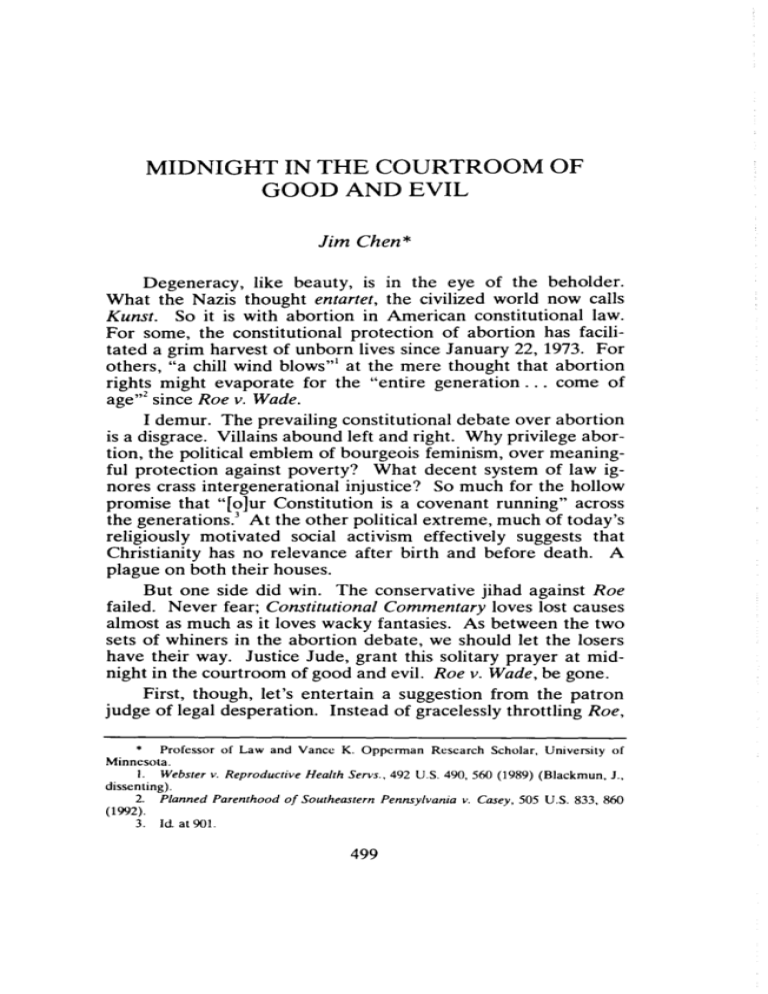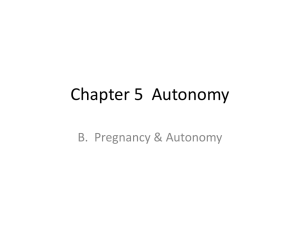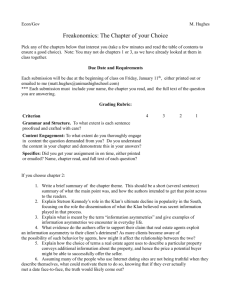16_03_Symposium_Chen
advertisement

MIDNIGHT IN THE COURTROOM OF GOOD AND EVIL Jim Chen* Degeneracy, like beauty, is in the eye of the beholder. What the Nazis thought entartet, the civilized world now calls Kunst. So it is with abortion in American constitutional law. For some, the constitutional protection of abortion has facilitated a grim harvest of unborn lives since January 22, 1973. For others, "a chill wind blows" 1 at the mere thought that abortion rights might evaporate for the "entire generation ... come of age" 2 since Roe v. Wade. I demur. The prevailing constitutional debate over abortion is a disgrace. Villains abound left and right. Why privilege abortion, the political emblem of bourgeois feminism, over meaningful protection against poverty? What decent system of law ignores crass intergenerational injustice? So much for the hollow promise that "[o]ur Constitution is a covenant running" across the generations. 3 At the other political extreme, much of today's religiously motivated social activism effectively suggests that Christianity has no relevance after birth and before death. A plague on both their houses. But one side did win. The conservative jihad against Roe failed. Never fear; Constitutional Commentary loves lost causes almost as much as it loves wacky fantasies. As between the two sets of whiners in the abortion debate, we should let the losers have their way. Justice Jude, grant this solitary prayer at midnight in the courtroom of good and evil. Roe v. Wade, be gone. First, though, let's entertain a suggestion from the patron judge of legal desperation. Instead of gracelessly throttling Roe, * Professor of Law and Vance K. Opperman Research Scholar, University of Minnesota. I. Webster v. Reproductive Health Servs., 492 U.S. 490, 560 (1989) (Biackmun, J., dissenting). 2. Planned Parenthood of Southeastern Pennsylvania v. Casey, 505 U.S. 833, 860 (1992). 3. Id at 901. 499 500 CONSTITUTIONAL COMMENTARY [Vol. 16:499 why not eliminate that decision's immediate precedent? There is, after all, a respectable argument that protecting contraceptive use by atomistic individuals is a nation's surest symptom of moral decay. Besides, there lies an immense amount of perverse pleasure in playing havoc with the lives of American law students, who tend to be unmarried, fertile, and heterosexually active. Very well then. Stomp that butterfly: let's assume that in 4 Eisenstadt v. Baird, the Supreme Court refused to guarantee unmarried persons a constitutional right of access to contraceptives. Eisenstadt, truth be told, could have and arguably should have confined Griswold v. Connecticut5 to contraceptive use by married couples. Stripped of its fundamental rights veneer, Eisenstadt would have proved an exceedingly simple application of rational basis review. The government has a "strong interest" in controlling the sexual activity of young, unmarried heterosexuals.6 And how can a classification disadvantaging unmarried persons be suspect? Eisenstadt thus reimagined would have dictated the opposite outcome in Roe. Denying a general right to contraception surely would have foreclosed any claim that abortion should be a fundamental right. Eisenstadt's closest cousin, Carey v. Population Services International, 7 would also disappear. "If you want contraceptives," a state could insist, "visit a pharmacist." The Court would have to confess that Griswold must "be read as holding only that a State may not prohibit a married couple's use of contraceptives. "8 Reversing Eisenstadt, Roe, Carey: this is either a cultural conservative's lurid fantasy or a progressive's nightmare. But Roe would hardly represent the Court's final word on the civil liberties of pregnant women. The next Term presented two opportunities to revisit the issue. Cleveland Board of Education v. LaFleur9 invalidated a school board rule requiring mandatory leave for pregnant teachers. More pointedly, 4. 405 u.s. 438 (1972). 5. 381 u.s. 479 (1965). 6. Michael M. v. Superior Court of Sonoma County, 450 U.S. 464,470 (1981) (plurality opinion). 7. 431 u.s. 678 (1977). 8. ld at 687 (emphasis added). 9. 414 u.s. 632 (1974). 1999] SYMPOSIUM: CHEN 501 Geduldig v. Aiello 10 asked whether the equal protection clause prohibits discriminatory treatment of pregnancy. Pregnant persons are, surprised though Justice Stewart might have been to discover, invariably female. Had a substantive due process theory of abortion failed in Roe, Geduldig would have given a creative and opportunistic Court the platform for protecting abortion rights as a matter of equal protection. Doctrinal uncertainty over sex-based classifications11 would hardly have prevented Justice Brennan from arguing that equal protection requires careful scrutiny of classifications based on "physical characteristics inextricably linked to one sex." 12 "More is involved than the abstract question whether disparate treatment of pregnancy discriminates against a suspect class, or whether abortion or childbirth is a fundamental right." 13 Or so the Burger Court's doctrinal genius might have written. "In light of the countervailing costs, discriminatory legislation that impairs a woman's control of pregnancy can hardly be considered rational unless it furthers some substantial goal of the State. " 14 In a world without Roe v. Wade, the right to abortion could be rooted in equal protection instead of substantive due process. The regulation of abortion, unique as that medical procedure is to women, would have to survive comparisons with the regulation of equivalent medical practices affecting men alone, or both men and women. Although Roe in real life stressed the primacy of the doctor-patient relationship, it is hard to imagine how the loss of a fundamental rights fa~ade could have altered the Supreme Court's seemingly ad hoc approach to the regulation of 15 abortion as a medical procedure. Unemancipated, unmarried girls have never had much freedom to end their unwanted pregnancies. Only once did the Court under Roe invalidate a parental notice or consent law that allowed some sort of judicial by- 10. 417 U.S.484 (1974). II. See Frontiero v. Richardson, 411 U.S. 677 (1973). 12. Geduldig, 417 U.S. at 501 (Brennan, J., dissenting); cf., e.g., Ruth Bader Ginsburg, Some Thoughts on Autonomy and Equality in Relation to Roc v. Wade, 63 N.C. L. Rev. 375, 386 (1985) (suggesting that the right to abortion should have been framed as a question of equal protection). 13. Plyler v. Doe, 457 U.S. 202,223 (1982) (altered quotation). 14. ld. at 224 (altered quotation). 15. See, e.g., Planned Parenthood of Missouriv. Danforth, 428 U.S. 52 (1976); City of Akron v. Akron Center for Reproductive Health, Inc., 462 U.S. 416 (1983); Thornburgh v. American College of Obstetricians & Gynecologists, 476 U.S. 747 (1986). CONSTITUTIONAL COMMENTARY 502 [Vol. 16:499 16 pass. Modern substantive due process originated, after all, in cases defending the rights of parents to rear their children. 17 No doctrine, whether rooted in substantive due process or in equal protection, is likely to dislodge the dogma that parents know best. The upshot is that Roe was no prize. As the weakness of the funding cases showed, 18 Roe was scarcely a robust specimen of fundamental rights jurisprudence. Protecting abortion rights as a matter of equal protection would have fared no worse than Roe's imperfect substantive due process strategy. 19 Superior textual legitimacy would be a nice bonus, a luscious lagniappe. One nagging problem remains. How could the Court have denied the claims in Eisenstadt and Roe without overruling Griswold? Why, of course, by stressing that portion of Griswold which enshrined marriage as "an association for as noble a purpose as any" other, a "coming together ... intimate to the degree of being sacred. " 20 Thanks to the Court's heroic efforts to distinguish between the use of contraceptives by married couples and their use by unmarried individuals, the notion of marriage would emerge as a full-fledged fundamental right. The seeds 1 planted in Lovinl and Boddie22 would finally bear fruit. Eliminating Eisenstadt would therefore spark two dramatic doctrinal changes. First, equal protection of the sexes would explicitly secure the right of women to seek the full range of medical responses to pregnancy, including abortion. Stomping Eisenstadt would coincidentally crush Roe, but Geduldig would have filled that vacant jurisprudential niche. Second, marriage rather than reproductive self-determination would animate the con- 16. See Bellotti v. Baird, 443 U.S. 622 (1979). Compare Lambert v. Wicklund, 520 U.S. 292 (1997) (per curiam) (upholding a parental-rights provision with judicial bypass); Ohio v. Akron Center for Reproductive Health, 497 U.S. 502 (1990) (same); Planned Parenthood Ass'n v. Ashcroft, 462 U.S. 476 (1983) (same) with Hodgson v. Minnesota, 497 U.S. 417 (1990) (invalidating a parental-rights provision without judicial bypass); H.L. v. Matheson, 450 U.S. 398 (1981) (same). 17. See Meyer v. Nebraska, 262 U.S. 390 (1923); Pierce v. Society of Sisters, 268 U.S. 510 (1925); Prince v. Massachusetts, 321 U.S. 158 (1944). 18. See Maher v. Roe, 432 U.S. 464 (1977); Harris v. McRae, 448 U.S. 297 (1980); see also Rust v. Sullivan, 500 U.S. 173 (1991); Webster v. Reproductive Health Servs., 492 U.S. 490 (1989). 19. Sec David A. Strauss, Abortion, Toleration, and Moral Uncertainty, 1992 Sup. Ct. Rev. 1, 27. 20. Griswold v. Connecticut, 381 U.S. 479,486 (1965). 21. Loving v. Virginia, 388 U.S. 1 (1967). 22. Boddie v. Connecticut, 401 U.S. 371 (1971). 1999] SYMPOSIUM: CHEN 503 temporary view of fundamental rights of privacy and personhood. Practically speaking, these doctrinal transformations would reverse the actual law on access to contraceptives but preserve (or even expand) the constitutional protection of abortion. Without Eisenstadt, unmarried Americans would have no right to contraceptives, but adult women, regardless of marital status, would enjoy relatively free access to abortion. A modest but creative extension of equal protection would preserve abortion law more or less as we know it. A fundamental rights jurisprudence based on marriage rather than reproductive autonomy would reinforce rather than negate the Supreme Court's hostility to requiring a married woman to consult her husband before seeking an abortion. 23 In its sexual mores if not its economic affairs, the United States of this imaginary legal universe would resemble the very real nations of the former Soviet bloc. Or perhaps America would resemble Japan, which only recently legalized oral contraceptives. Abortion would be a common method of birth control, at least among the unmarried. 24 One final legal change bears noting. Griswold shorn of Eisenstadt and Roe subtly but significantly alters the constitutional notion of marriage. Securing the right of married couples to contraceptives symbolically negates the view of marriage, so prevalent in traditional legal and ecclesiastical circles, as a privileged, even exclusive, channel for reproduction. With this observation, let's bring our legal fantasy to its logical conclusion. Imagine what Justice Brennan could have done with a fundamental rights jurisprudence based solely on Griswold. In a concurrence that was unusually shrewd even by his own standards, Justice Brennan in 1986 could have joined a unanimous Court in upholding Georgia's sodomy law. 25 Michael Hardwick admittedly had engaged in sodomy with someone other than his spouse. And marriage is "the only relationship in which [the government] allows sexual relations legally to take place." 26 Jus23. See Planned Parenthood of Southeastern Pennsylvania v. Casey (cited in note 2); Planned Parenthood of Missouri v. Danforth, 428 U.S. 52,67-72 (1976). 24. Or so it might be if the states actually were fatuous enough to ban contraceptives. Perhaps this takes too dim a view of American legislators. That a policy is constitutional doesn't make it plausible, much less prudent. It might be more realistic to imagine great variation among communities in age limits for contraceptive purchases and in contraceptive distribution policies for public schools. But adults in their 20s and 30s would probably encounter no serious barriers to securing contraception. 25. Cf. Bowers v. Hardwick,478 U.S.186 (1986). 26. Zablocki v. Redhail, 434 U.S. 374,386 (1978). 504 CONSTITUTIONAL COMMENTARY [Vol.l6:499 tice Brennan would take pains, however, to note that the sodomy ban, "uncommonly silly" even by the low baseline set in 27 Griswold, might present a different question if enforced against a married couple. A decade later, Hawaii might have accepted Justice Brennan's transparent invitation. If incarcerated heterosexuals can marry, 28 why not free homosexuals? In the wake of Romer v. 29 Evans, Hawaii would become the first state to recognize marriages between persons of the same sex. Citing Griswold and Justice Brennan's concurrence in Bowers, Hawaii's supreme court would invalidate the sexual classification in that state's marriage law. 30 In an unusual joint opinion for six Justices, the Supreme Court of the United States could affirm: "Equality knows no refuge in a jurisprudence of hate. "31 The federal Defense of Marriage Act would lie in ruins. Heterosexual hegemony over the institution of marriage would end at last. Thank you, Justice Jude. Exchanging Eisenstadt, Casey, and the meaningless shell of Roe for same-sex marriage seems an uncommonly good swap. Call it "gay science" of a different sort: tracing the genealogy of constitutional morals can indeed move us beyond conventional notions of good and evil. Roll over, Blackstone; Nietzsche rules. One man's Kulturkampf is an. . 32 ot her ' s war of emancipation. 27. Cf. Griswold v. Connecticut, 381 U.S. 479,527 (1965) (Stewart, J., dissenting). 28. See Turner v. Safley, 482 U.S. 78 (1987). 29. 517 u.s. 620 (1996). 30. In real life, Hawaii's supreme court did invalidate that state's marriage law on state constitutional grounds. See Baehr v. Miike, 1996 WL 694235 (Haw. Cir. a., Dec. 3, 1996), afrd without opinion, 950 P.2d 1235 (Haw. 1997); see also Baehr v. Levin, 852 P.2d 44 (Haw. 1993) (requiring the state to justify the limitation of marriage to heterosexual couples). 31. Cf. Planned Parenthood of Southeastern Pennsylvania v. Casey at 844 (cited in note 2) (altered quotation). 32. Compare Romer, 517 U.S. at 636 (Scalia, J., dissenting) with Cohen v. California, 403 U.S. 15, 25 (1971 ).






